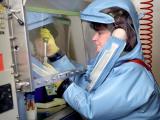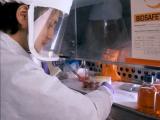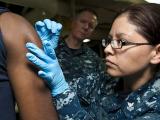Oct 24, 2002 (CIDRAP News) – A large-scale bioterrorist attack on US agriculture would probably not lead to famine or malnutrition, but it could damage the economy, public health, and public confidence in the food system, according to a report recently released by the National Academies' National Research Council.
The 123-page report, titled Countering Agricultural Bioterrorism, says the nation needs a comprehensive plan for responding to the intentional introduction of pests and pathogens into the nation's crops and livestock. The report recommends a long list of preparedness measures, from basic research on plant and animal pathogens to the appointment of experts to explain matters to the public in the event of an attack.
The document says that harmful biological agents "are widely available for intentional introduction and pose a major threat to US agriculture. Technical sophistication would not be necessary for attacks with some of these threat agents." Further, "A large-scale multifocal attack on agriculture could not be responded to or controlled adequately or quickly and would overwhelm existing laboratory and field resources."
The report was prepared by the 13-member Committee on Biological Threats to Agricultural Plants and Animals, led by Harley W. Moon, a professor of veterinary medicine at Iowa State University in Ames. The group held a series of five meetings from May 2001 through January 2002. The document was released in September but is available only by purchase from the NationalAcademy Press (see link below).
In preparing the document, the committee wrote detailed descriptions of several specific pathogens that could be used by agricultural bioterrorists, but the information was put in an appendix that is not available to the public. Though the US Department of Agriculture and the Office of Homeland Security reviewed the report for sensitive information, the National Academies decided on their own to withhold the material, according to a statement the latter agency made when it released the report. ("The National Academies" is the collective name for the National Academy of Sciences, National Academy of Engineering, Institute of Medicine, and National Research Council.)
Describing the challenges
Assessing the possible effects of an attack on agriculture, the committee wrote, "Although an attack . . . is highly unlikely to result in famine or malnutrition, the possible damage includes major direct and indirect costs to the agricultural and national economy, adverse public-health effects (especially if the agents are zoonotic), loss of public confidence in the food system and public officials, and widespread public concern and confusion."
The panel said that plugging gaps in the nation's existing defense against natural threats to agriculture will not adequately protect the country from intentional threats. And as of last spring, the committee could not find any publicly available "interdepartmental national plan" for defense of agriculture or an accepted "threat list" that could be used in developing such a plan.
In other findings, the report says:
- "There are important gaps in our knowledge of foreign-plant and foreign-animal pests and pathogens."
- Controls at US borders are not aimed at intentional biological threats and are scanty in any case. For example, the USDA's Animal and Plant Health Inspection Service checks only 1% of incoming private vehicles.
- There is no comprehensive system for screening, identifying, and reporting pests or pathogens found by informal surveillance.
Specifications for a national plan
The committee recommends that a national defense plan include both domestic and international strategies and that it clearly spell out the roles of the USDA and its "key partners," such as defense, intelligence, public health, law enforcement, and state and local agencies, in coping with the threat.
Though it is not possible to prepare for all threats, the report says, "The committee recommends that a short, interagency threat list be developed and specific planning conducted for each agent on the list to determine proper roles, resource allocations, laboratory strategy, research priorities, and so on."
To help predict where pests and pathogens are most available and trace outbreaks to their sources, the report advocates research on the major strains and subtypes of such agents worldwide.
In other recommendations, the committee advocates:
- Creation of an agriculture laboratory response network, patterned after the public health system's Laboratory Response Network, for analysis of biological threats. A footnote says that USDA announced on May 30 that it would allocate $20.6 million to states and universities for a network of labs to diagnose animal diseases.
- More efforts to develop tools to rapidly detect and diagnose high-priority pests, pathogens, and diseases
- Creation of a national communication, data-management, and information system for agricultural bioterrorism, modeled after the Centers for Disease Control and Prevention's Health Alert Network.
- Use of "pathway analyses," including attack simulations, for some threat agents to spot and correct weaknesses in the nation's response capabilities.
- Efforts to help other countries control their natural agricultural pests and pathogens
- Planning for communication with the public in the event of an attack. This should include naming a lead spokesperson for each class of agents, a public information plan for each class, and communication training for local officials.
- A comprehensive education program for the agricultural community to increase recognition of diseases and improve response
- Increased research on the biology, epidemiology, and pathogensis of animal and plant diseases and the "social and behavioral aspects of agricultural bioterrorism"
Also, to foster public-private cooperation and information sharing in this area, the panel recommends setting up a public-priviate advisory council at the level of the secretary of agriculture. "The committee recommends this as an important, low-cost first step through which different or larger initiatives could be proposed," the report says.
The committee's suggested priorities for immediate action include naming spokespersons for classes of threat agents; defining roles and authority at the federal, state, local, and private levels; developing the list of important threat agents for planning; and developing "model scenarios" of attacks.
See also:
National Academy Press catalog page for buying the report, plus link to press release [Click here]
Editor's Note: Full text of the report has become available since this story was written [Click here]















